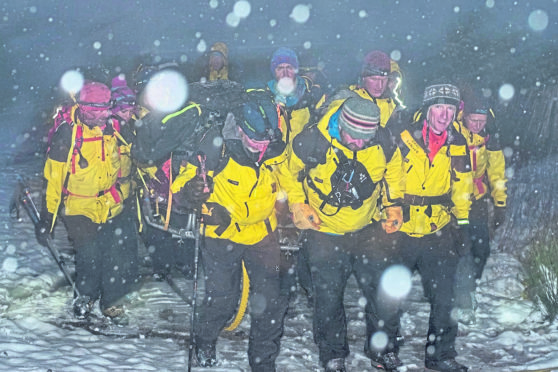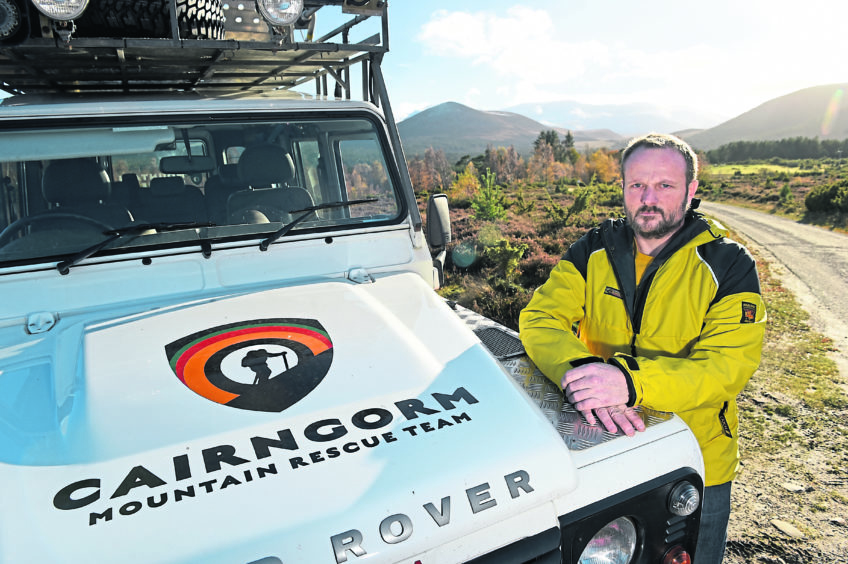Scotland’s busiest mountain rescue teams have hit out at a “casual disregard” for their safety over the use of helicopters in search operations.
Members of Glencoe, Tayside, Lochaber and Cairngorm teams released a joint statement yesterday claiming they are repeatedly denied help in retrieving bodies from the hills, because dead people are not “persons in distress”.
They also attacked rescue co-ordinators, who they refer to as “agencies”, for an increasing unwillingness to to help get crew and their gear safely back to base after an operation.
One team leader warned that lives were “potentially at risk” and that he feared only the serious injury or death of a colleague would make those who co-ordinate resources sit up and take notice.
It is claimed the problems started when a new contract meant Coastguard helicopters replaced miltary craft in the national Search and Rescue (SAR) network – a contract signed in 2013.
The teams – known collectively as iSMT (Independent Scottish Mountain Rescue) – say they have been forced to speak publicly now because they have been ignored or rebuffed by officials – most notably by a junior minister who they claim accused them of laziness.
The joint statement reads: “As the teams prepare to undertake difficult and potentially dangerous rescues in such winter conditions the teams have decided that they can no longer accept an apparent casual disregard for the safety of the volunteers shown by the Agencies coordinating Search and Rescue helicopter operations.
“The team’s volunteers are well trained, well equipped, very capable and robust but they are not invincible.
“The teams in iSMR simply object to being apparently seen as expendable by the Agencies.”
The statement goes on to reassure the public that they will continue to “search for, rescue and recover your loved ones, despite the apparent lack of support from certain Agencies”.
Last night Al Gilmour, chairman of Cairngorm Mountain Rescue Team, added: “I do fear it is going to take a rescue team member getting injured or killed before agencies will then say they see what we are talking about, but we do need discussion.
“Potentially lives are at risk if we are using that resource to deal with a fatality and having to walk a body off the hill.”
The iSMR were at pains to make clear that any criticism “is aimed purely at the coordination of the service”.
Those involved in coordinating search and rescue helicopter operations include the Maritime and Coastguard Agency (MCA), the Aeronautical Response Coordination Centre (ARCC), the UK Government’s Department for Transport and Police Scotland.
The MCA said: “While the recovery of bodies positively confirmed as deceased is not strictly speaking a search and rescue mission, it is a mission HM Coastguard may support under some circumstances. Our crews… will attempt to assist the recovery of a dead body if the level of risk to the crews and their passengers… is not considered to be too great. This is a dynamic risk assessment conducted on a case-by-case basis taking into account the level of risk.
“Search and rescue helicopters should not routinely be required to clear the hill as fundamentally, a Mountain Rescue (MR) Team must be able to operate independently and without helicopter support as conditions on the day might mean that our helicopters are simply unable to reach a team on the hill.
“However, in circumstances where an MR Team are on a rescue and where there is a clear risk to the MR Team, the helicopter can be asked to remove them from the area to a place of safety.”
Mr Gilmour added: “We would like it written into the contract that a rescue isn’t over until all members are back at base.
“I think there needs to be the right level of respect shown in responses to our contact. We are not asking for a magic or unrealistic response but there needs to be a respectful and realistic conversation that will affect change.”
The four iSMR teams also claimed despite raising concerns since the inception of the latest contract in relation to the coordination of search and rescue helicopter operations, these have either been “rebuffed” or completely ignored.
This includes a letter from junior dfT minister Nusrat Ghani, suggesting rescue team members “should be able to operate independently”.
‘Lazy’
The iSMR teams raised concerns over a letter written by Department for Transport minister Nusrat Ghani, which they claim implied mountain rescue members were being “lazy”.
Within the letter, addressed to Ian Blackford MP, Miss Ghani said: “The recovery of positively confirmed fatalities is not, strictly speaking, a search and rescue mission; it is a mission that Her Majesty’s Coastguard may support under some circumstances.
“I understand that SAR helicopters should not routinely be required to clear the hill as a Mountain Rescue team should be able to operate independently and without helicopter support.”
The iSMR teams said: “It is felt that the Agencies have been clear here as to their opinions. They clearly do not view the welfare of the volunteer teams as of significant enough importance as to warrant the continued air support to clear the hill.
“They have also been cheeky enough to say that the teams ‘should’ be able to make their own way off the hill. Perhaps implying that the teams are lazy?”
Ian Blackford MP replied last night saying: “It is astonishing and insulting and I believe the minister has to show some appreciation for what the volunteers of the mountain rescue teams are doing because they deliver a crucial service in our communities.
“I find it extraordinary. The mountain rescue teams deserve the respect and support of rescue services as well as they are exposing themselves to sudden risks.
“I appreciate helicopters are only deployed in a manner that it is safe and, if it is safe to do so, I believe they should be assisting mountain rescue teams at all times.
“I will consult with the mountain rescue teams but I am very happy that we go back and say this simply isn’t good enough. There is no question about that.”
The scenarios
Within their statement, the iSMR presented scenarios where volunteer teams were denied the assistance of the search and rescue helicopter despite being in dangerous and tricky situations.
The iSMR said: “The Agencies have repeatedly refused to assist teams with the recovery of bodies of people killed in the mountains. The view of the Agencies concerned has apparently been that the deceased are not ‘persons in distress’ and therefore assistance with recovery is not offered.
“The result of this has included examples such as – one incident where volunteer teams had to undertake an incredibly dangerous lower of the stretcher and team managing the body down a narrow gully, dodging rockfall whilst the aircraft was instructed to standby.”
It is claimed by the iSMR that the helicopter was only to react in the event one of the rescuers being injured.
Another incident is said to have occurred on the hottest day of the year where one team member, under constant risk of rockfall, was forced to carry all equipment required to access and recover a body thousands of feet up a mountain, again with no assistance from the search and rescue helicopter.
The iSMR added: “Even though assistance was requested it was again instructed not to assist, not even to carry the equipment. Ironically, while the recovery was ongoing another incident occurred within a few hundred metres and when the helicopter responded to this incident, the crew were surprised that they had not even been informed of the team’s request for assistance.
“In any of these incidents, the priority should surely be to minimise the distress and suffering for the families and give the maximum respect for the deceased.”

